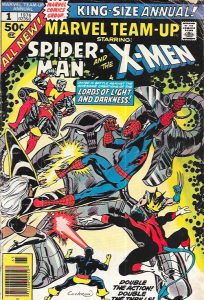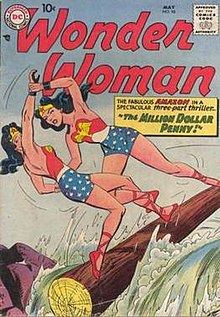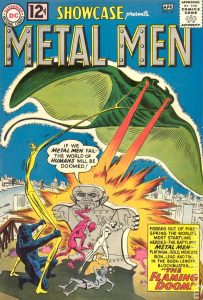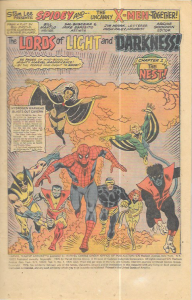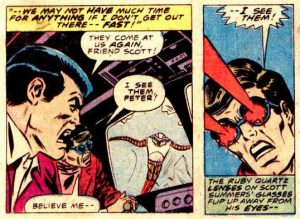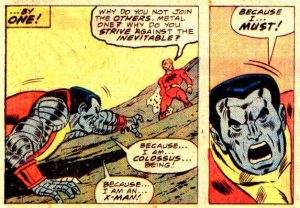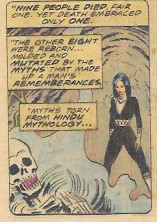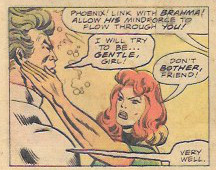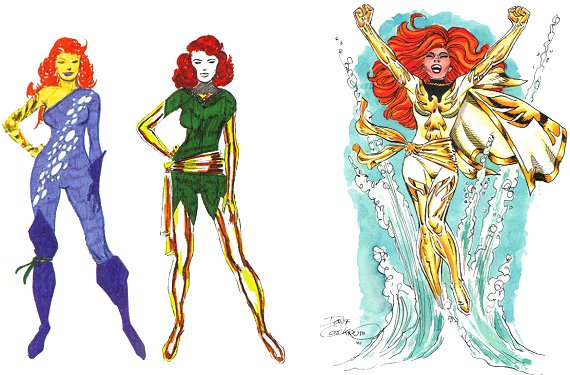This week, while working on a blog post about Scottish politics (not kidding—just got back from Scotland and was fascinated by some comments made by an excellent tour guide),
I decided to take a detour into nostalgia. I quaffed down a Slurpee and inhaled a couple cans of Pringles and re-read a favorite comic book. Okay, I read a comic book. The other stuff will stay a pleasant memory, because, while 11-year-old me had the metabolism of a blast furnace, 57-year-old me gains eight ounces just by typing the words “Cheese Waffles.”
I’ve read this issue probably a hundred times—99 of them, sadly, before I was 15, and the last this week. From the depths of a long box in my office, it’s been calling to me, “Please read me again!” Finally, I did. Why that particular comic called out to me, I’ll get into at the end.
“Lords of Light and Darkness” was written by Bill Mantlo, who also wrote my favorite Iron Man arc and created iconic MCU character Rocket Racoon. It was pencilled by Sal Buscema, veteran of The Avengers and The Defenders, and inked by Mike Esposito, the regular inker on MTU. Esposito is best known for developing, with Ross Andru, the distinctive look of the Silver Age Wonder Woman and for creating the Metal Men with Andru and Bob Kanigher. Chris Claremont, who transformed the X-Men from Stan Lee and Jack Kirby’s only failed super-hero idea into a genre-defining force, is credited with conspiring on the plot, as is colorist Bonnie Wilford. Dave Cockrum, co-creator of the New X-Men with Len Wein, and regular X-Men artist at the time, contributed the cover.
There are SPOILERS below.
The story begins with an unusual narrative technique: Chapter 1 –“The Nest”—is narrated by a character who is dead. Not a ghost. Not case of surprise resurrection. This guy is stone cold dead. Okay, actually, given the way he died, his skeletal remains are probably damn hot. Still, he tells us he’s a goner in panel two of page two. Since this is one of the rare Marvel comics of its time with a symbolic splash page (a page that is not part of the narrative), that means we know he’s gonna die from page one.
The narrator proceeds to relate how, as a special investigator to the U.S. Senate, he came to the Nevada desert to check out “The Nest,” a super-secret government installation. He introduces all eight (pretty small government facility!) of The Nest’s team and gives capsule bios. In typical Marvel (and even more typical Mantlo) touches, he’s been married to one of them, and his ex-wife left him for one of the others. It’s also really Seventies. You could easily see Steve Austin walking into this situation on The Six-Million Dollar Man.
But The Nest never accomplishes its stated goal of “Solving the problem of the world’s depleting energy resources,” because, on page seven, it blows up. To paraphrase Big Jim McBob and Billy Sol Hurok, it blows up good. It blows up real good. The shielding around the nuclear pile that is apparently the core of the operation is shattered by an earthquake, and the pile goes critical.
The pile, as pictured in this story is a literal pile of glowing material, presumably a big honking pile of something like U-238. In fact the term “atomic pile” was used for early model nuclear reactors, based on the fact that moderating graphite was piled around the reactive mass. I’m pretty sure the term was out of style by 1976, but it adds to the Hammer Films creepiness of this scene.
It’s a very Seventies-style disaster, and our narrator is now dead. Presumably, so are the eight scientists we just met.
But that’s okay, because no one bought this comic to meet eight scientists and a Fed. They bought it to see the X-Men and Spider-Man in action, and Chapter II—“Day of the Demons”—delivers that. Well, eventually. (And yes, the numbering went from “1” to “II.” Oops. Jim Novak on letters may have been in a hurry.)
There’s a conference in progress, on “man-made mutation.” It’s not in a hotel or at a university. No, it’s aboard a 747 which, with refueling, will stay aloft for a week so that the delegates to the conference will not be interrupted. Readers in the Seventies believed planes were luxurious, so this probably struck us as really glamorous. I mean, there are all those photos of the Sixties jet-setters, stretched out on LaZBoy recliners, being served meals on the good China! Planes were flying palaces!
Me, I can’t imagine spending days on a plane. They’re smelly, cramped, and loud. I’d sooner hold a conference in the men’s room of a Fell’s Point bar. Also, my quick research of the topic says that in-flight refueling is not practical for passenger aircraft and a multi-day event has never been held on a plane. But, again, it was the Seventies and Airport ’75 had made a lot of money, so…
The delegates to this conference include Sir Lionel, Dr. Fermizi, Dr. Mishkin of the Soviet Union and his idiot brother-in-law, Boris—a translator who speaks almost no English. Forget all of them but Mishkin and Boris, for they don’t speak after they serve to introduce Peter Parker, on board with other reporters, but a favorite because he’s a student of physics. Oh, and this guy Senator Turner speaks. A lot. Apparently, is also a supporting character in Skull the Slayer, which I have not read to this day. But he’s basically Joe McCarthy. Forget him, too, because he’s just there to bluster for a few panels and be threatened by a feral Canadian.
Which brings us to the final delegate. He comes with an entourage and is named Charles Xavier. His entourage is, of course, the X-Men. (Still, at that time, “The All-New, All Different X-Men,” though not on the cover of this issue.) Why did Professor X feel the need to bring the whole school with him? It’s never stated. Maybe he didn’t trust all six of the others to babysit Wolverine?
With the stars of the story all in place, things start to happen quickly. A black cloud appears in the plane’s flight path, the plane loses altitude, robots shoot up out of the desert and begin firing eye-beams at the cockpit. Peter Parker changes into his Spider-Man uniform. Peter Rasputin (we weren’t anal-retentively calling him “Piotr” in those days) and Scott Summers land the plane.
Stray memory—this was the story that revealed to me that Scott Summers was not blind. When I saw him for the first time—and that was on a Slurpee cup, not in a comic book—I assumed that he wore dark glasses when not in costume for the same reason Matt Murdock did. I thought Scott’s optic blast power also kept him from seeing. Silly me, because, when Colossus calls out in alarm that the robots are circling around for a second volley, Scott replies, “I see them, Peter! Believe me—I see them!”
The Senator accuses the X-Men of being in league with the commies, while the clear-headed Dr. Mishkin finds both the source of the attacking robots and a huge radioactive anomaly in the middle of the desert, using “the world’s most sophisticated radiation detector–! {sic} Invented specifically to be unveiled at this conference!” He then helpfully produces his anti-radiation spray (I mean, did you ever?). He brought it with him as a demonstration of the USSR’s “advanced mutation research.” What an anti-radiation spray has to do with mutation is not explained. I suppose it prevents it? And the detector? Colossus says, “Professor! There is a similarity between my countryman’s device and your Cerebro!”
Um… sure, Pete. The detector is green, and, depending on who’s coloring any given issue of X-Men, sometimes Cerebro is also… green? I mean, I guess. The detector finds roentgens. Cerebro finds mutants. I suppose they both find what it is you’re looking for.
Anyway, Commies 3, McCarthy 0. But Boris still has no idea what’s going on.
In “Chapter 3: Into… Hellpit!” (yes, we’re back to Arabic numerals), Spidey and the X-Men, all sprayed-down and anti… radioactive… able, charge into the mound from whence came the robots. Spidey and Wolverine almost fight, because, y’know, that’s what Marvel heroes do. Then the group is attacked by two people who look very familiar. One says he is Yama Dharma, god of death. The other is Kali, the chaos-bringer. But they also look like the Swedish and Chinese scientists we met in Chapter One. Battle ensues, and our heroes are defeated. As Yama and Kali round up their unconscious foes, they realize that Jean Grey (still in plain clothes, unlike her comrades) is “The One.”
Two touches I really like here. First, as Wolverine tries to literally rip the guts out of Yama with his claws, he finds that his foe is not human and, oh my God, he’s full of stars! Wolvie freaks out. Not many heroes actually freaked out in those days, and it was refreshing. I think it partially explains Wolverine’s (eventually sickening) popularity with fans.
The other moment I really like comes when Colossus, the last X-Man standing, claws his way up the hill to confront his foes as Kali’s Chaos Wheel is literally scrambling his neurons. Yama asks him why he doesn’t just lie down and accept defeat. Peter responds, “Because… I am… Colossus… being! Because… I am an… X-Man! Because I… must!” The gifts of rhetoric granted the X-Men in particular back in the day are nothing short of inspiring. I credit Chris Claremont, as well as Bill Mantlo for maintaining their special tone of voice even in a guest-shot.
“Chapter 4: A Gathering of Gods!” opens with all the scientists from Chapter 1 lined up facing away from us, gazing down at a kneeling, unconscious Phoenix. (At last!) In very classic Marvel style, the rest of our heroes are imprisoned in a formless energy prison behind her. We learn the new names of all of the scientists, who have taken on the aspect of Hindu gods: Brahma, Shiva, Mara, Agni, Vishnu and Ratri. Yama and Kali we already met.
How did eight Federal-employee scientists become Hindu gods? Well, apparently, it happened when the pile went critical and destroyed the Nest. Araman Nila, the inventor of the thing, was standing closest to it. His mind was “Ripped out! Twisted! Searched for memories and bombarded with unknown levels of radiation… infusing all with the stuff of his thoughts, of his mind… reborn… molded and mutated by the myths that made up a man’s remembrances.” As mentioned, our Chapter One narrator didn’t level up to god. He just died. We’re shown a panel of his ex-wife looking down on his smoking skeleton.
Now… okay… your average nuclear reactor, if it goes critical, does not suddenly become aware and look for the minds of human beings to rip out, twist, mold and mutate. It pretty much just melts them. But the narration here tells us Nila’s mind was “searched.” Searched by whom? That single word implies that there was an intelligence behind the conversion of these humans into higher beings, but the implications of that intelligence are never explored.
Plot hole, you say? Please, this was the 1970s. If Moonbase Alpha could be shepherded through the cosmos by a Mysterious Unknown Force for 48 episodes, then eight scientists could be intentionally transformed into Hindu gods, and we don’t need to know who’s behind it. You swallow it, you enjoy the story, and you move on. In time, you’ll find out it was Judi Dench all along. True story.
Anyway, Brahma explains that they need Phoenix to become their ninth member. (They really musta hated that ex-husband guy. They had an opening, and they let him fry anyway.) Her power will bind their energies together, so that they’ll transform into something even more advanced. Oh, and the Earth will be drained and left a dead husk. But, if they don’t transform, they die.
Well… we gotta stop them, right? Good thing that the X-Men and Spidey, using JLA-style teamwork to let each of their powers free someone else, have broken free. A quick battle ensues, during which Brahma and the Brahmettes suddenly start to dissolve. They’ve waited too long to transform, and they’re gonna die.
Oh, and the Earth will die with them. Did we not mention…?
Spidey and Cyclops quickly (and apparently telepathically) form a plan to save everyone. It’s interesting, because neither of them is a telepath. Phoenix is a telepath, and yet she’s standing on the sidelines saying, “Tell us what to do, Scott.”
The plan is convoluted but gives every member of the team something to do. It goes like this: Phoenix telepathically links the gods, draws out their mindforce, passes it to Nightcrawler, who teleports it up in the air into the path of Cyclops’s optic blasts, where Banshee’s sonic scream keeps it stable while Storm keeps the resultant heat from baking Spidey, Colossus and Wolverine, who hold hands. Huh? Well, it’s kinda nice. Finally, with the mindforce ball in position, Cyclops blasts it, where light pressure presumably shoots it into outer space, and the gods become a star.
My favorite part of this (somewhat confusing) sequence is when Phoenix links minds with Brahma. He says, “I will try to be… gentle… girl!” Jean replies, “Don’t bother, Friend!” It’s a very typical Jean Grey response, at least Jean Grey as we knew her once Chris Claremont started writing the X-Men. Is she a masochist? No, I don’t think so. I think she’s just that tough. Jean was, is, and always will be my favorite of the X-Men. Anyone who says the only interesting thing she ever did was die has the storytelling equivalent of tastebuds that only respond to ghost peppers. They don’t appreciate the subtleties, they just want kick-ass chicks in tight costumes to make loud shooty-bangs happen.
And Jean may be one of the big reasons why this is one of my favorite “New” X-Men stories of the period. Because the main X-Men book was one non-stop story arc, we never got to see Phoenix as just a member of the team. And that’s what Dave Cockrum designed her to be: an updated, more powerful version of Marvel Girl, Jean’s 1960s alter ego, powerful enough to stand beside a more modern team of X-Men.
Trouble is, Dave did such a great job re-working her that she never did stand beside the X-Men. She stood above them. She was too powerful, too all-knowing, too… much. She had to be kept in the background lest she dwarf the others. Like, you know, how Thor couldn’t be an Avenger, or Doctor Strange couldn’t be a Defender, or Hulk couldn’t be, well, both.
Wait… Let’s see… what was different about Jean as opposed to all those other powerful characters? Nah, let’s not go there. Let’s just note that Jean as Phoenix only got to be “just one of the guys” pretty much in this story, which was released only two or three months after she blasted out of the waters of Jamaica Bay in her new identity.
And even here, she’s handled a little differently. She doesn’t put on a uniform and really join the fight until the very end. Hell, she’s not even on the cover! (Neither was she often on the covers of X-Men during her original 37-issue tenure as Phoenix.) But Banshee isn’t on the cover either. Maybe green costumes were just out of favor that year.
But, when she does power up and join the fight, it’s all about her.
So I think my great affection for this story (and I love it, despite my jabs above) stems from it being standalone, from Phoenix being pretty much just one of the team for a change, and from the 1970s ambience of technological horror mixed with mythological fantasy. This was the decade of Chariots of the Gods, and, boy, does this story show it!
I was fascinated by the “villains,” probably because I have always been a huge fan of myths. I discovered the Greek Myths first in the Hercules cartoon (produced in 1963 by Trans Lux Television) and then when our school librarian read us the story of Jason and the Argonauts in third grade. (From the wonderful D’aulaire’s Book of Greek Myths.) Unfortunately, these were one-off characters. As far as my personal knowledge and the many Marvel wikis extend, they never appeared again. Perhaps that’s because they weren’t really “mythological,” but derived from a living religion. There’s lots of opportunity to offend when you’re turning aspects of someone’s faith into a super-hero story, especially if you make their gods the villains.
Oh, one more thing about this story… it could not have happened. Well, obviously not, but I mean it could not have happened in the Marvel Universe timeline of 1976. Jean is Phoenix, so it’s set after X-Men #101. Charles Xavier says he is “living in a nightmare,” and an editorial aside says that nightmare begin in X-Men #97. That means he’s still undergoing the trauma of being linked to Princess Lilandra. That trauma was resolved in X-Men #108, when Lilandra and the X-Men won the battle to save the universe from her mad brother D’Ken, and she returned to Earth to be with Charles. So, this story has to be set between X-Men #101 and X-Men #108… which is impossible. There is literally no span of time during that run of issues during which the X-Men were a) together b) and on Earth and c) free to jump on a 747. Jean is hospitalized until X-Men #104, and the X-Men are in Ireland that entire time. They return to New York in #105 just in time to find Phoenix battling Firelord, and, at the conclusion of said battle, they all jump through a stargate and spend the next three issues in Shi’Ar space.
So, it’s an alternate universe teamup story, like Bob Haney always wrote for The Brave and the Bold or World’s Finest. They had absolutely no respect for the continuity of other books in which the characters appeared, but what stories!
If you made it this far, thanks for indulging me. I hope this detour to a simpler time was enlightening, entertaining or just plain fun.

